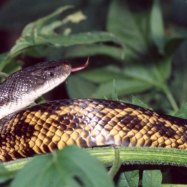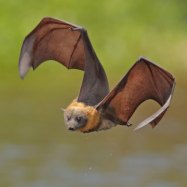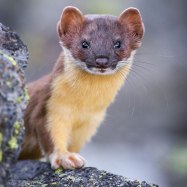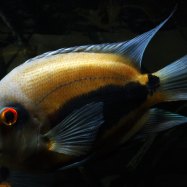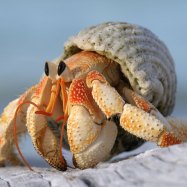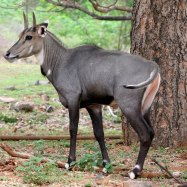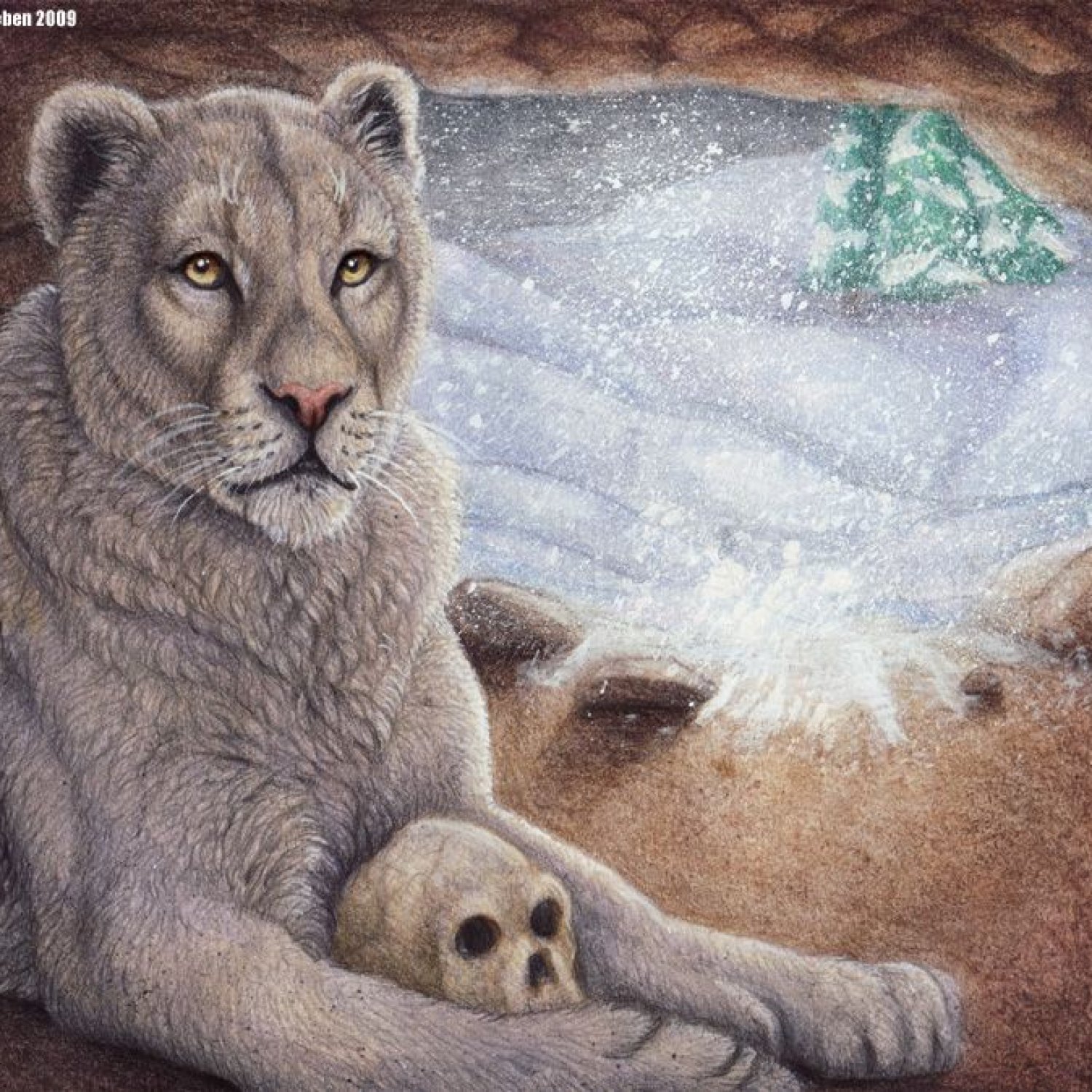
Cave Lion
Approximately 2.5 to 3.5 meters
The Cave Lion, also known as Panthera Leo Spelaea, was a majestic beast that roamed the earth thousands of years ago. This powerful predator had a length of about 2.5 to 3.5 meters and belonged to the Felidae family. Its body shape was impressively built with a large head and strong limbs. Sadly, this magnificent creature is now extinct, but its legacy lives on in the form of fossils and cave drawings.
Animal Details Summary:
Common Name: Cave Lion
Kingdom: Animalia
Habitat: Grasslands, open woodlands, and caves
A Legendary Hunter: The Mighty Cave Lion
Deep in the depths of the ancient caves, a fierce predator roamed, with an intimidating roar and a formidable presence. Its power and strength were unmatched, making it one of the fiercest predators of its time. This creature was none other than the mighty Cave Lion, also known as Panthera leo spelaea.Cave lions were a magnificent species of great cats that once dominated the grasslands, open woodlands, and vast caves of Europe, Asia, and North America Cave Lion. They were the largest predators of their time, with powerful bodies and a commanding presence that struck fear into the hearts of their prey. Let us take a closer look at the remarkable features and characteristics of this ancient predator.
The Taxonomy of the Cave Lion
Before we delve deeper into the world of the Cave Lion, it is crucial to understand its scientific classification. The Cave Lion belongs to the animal kingdom, Animalia, and the phylum Chordata. It is a member of the class Mammalia, the order Carnivora, and the family Felidae. Its genus is Panthera, which includes other well-known big cats such as the lion, tiger, and leopard.Panthera leo spelaea, or the Cave Lion, was given its scientific name in the early 19th century by the renowned German naturalist, Johann Friedrich Blumenbach. The name spelaea derives from Latin and means "of the cave," indicating the animal's habitat.
Ancient Extinction
Despite its powerful presence, the Cave Lion is an extinct species, with its last known sighting dating back to around 10,000 years ago Cane Rat. The timeline of their extinction aligns with the end of the Ice Age, suggesting that climate change may have played a significant role in their demise.At their peak, Cave Lions were estimated to have a significant population, with fossils discovered as far as the Middle East and Siberia. However, overhunting by humans and a changing environment gradually led to the decline of this magnificent species.
The Physical Characteristics of the Cave Lion
The Cave Lion, with its ferocious appearance, must have been an intimidating sight to behold for its prey. This ancient predator was powerfully built, with a large head, strong limbs, and a muscular body. Researchers believe that their physical attributes were adapted to their hunting style, which we will discuss later in this article.The Cave Lion's coat varied from Bluish-gray to reddish-brown, with a thick mane of fur around its head and neck. These features were similar to that of its modern-day relative, the African lion. However, unlike its modern counterpart, the Cave Lion was significantly larger, with males measuring approximately 2.5 to 3.5 meters in length, and weighing up to 220-320 kilograms (485-705 pounds). Females were slightly smaller, but still larger than most predators of their time.
The Habitat and Distribution of the Cave Lion
The Cave Lion's name is derived from its primary habitat – caves. However, this does not mean that they exclusively lived in caves. These magnificent beasts were also found in grasslands and open woodlands, making them extremely versatile and adaptable predators. While it is widely believed that they preferred to live in caves, their remains have also been discovered in various open areas, suggesting that they were not solely confined to living in caves.The Cave Lion was widely distributed, with fossils being discovered in Europe, Asia, and North America. This indicates that they had a vast range and were successful in different environments. The discovery of their fossils in such diverse regions provides scientists with valuable information about their migration patterns and how they adapted to various terrains and climates.
The Feeding and Hunting Habits of the Cave Lion
Carnivorous by nature, Cave Lions were apex predators, meaning they were at the top of the food chain. Their diet mainly consisted of large herbivorous animals such as bison, mammoths, and deer. They were skilled hunters, capable of taking down animals much larger than themselves.Their powerful body and sharp claws were essential tools in their hunting arsenal. The Cave Lion's strong limbs allowed it to pounce on its prey, while its sharp claws helped it bring down large animals. Their teeth were also specially adapted for hunting and feeding, with long and sharp canines that could deliver a killing bite.
One of the most exceptional features of the Cave Lion was its keen sense of smell and hearing, which were crucial for successful hunts. This, combined with its stealth and agility, made it a formidable predator, and its prey rarely stood a chance.
The Social Structure and Behavior of the Cave Lion
While there is limited information about the social behavior of Cave Lions, it is believed that they were social animals and lived in prides similar to modern-day African lions. However, due to the lack of evidence, it is challenging to determine the size and structure of these prides.It is believed that Cave Lions may have been territorial and fiercely protective of their hunting grounds. The discovery of many fossils of similar-sized individuals in specific areas suggests that they may have lived and hunted together.
The Significance of Cave Lion in Human History
As mentioned earlier, humans played a significant role in the extinction of the Cave Lion. These ancient predators were revered by humans and were often depicted in prehistoric art, such as paintings found in various caves throughout Europe. They were also a subject of spiritual and cultural significance, appearing in many ancient myths and legends.The Cave Lion's ferocity and hunting abilities proved to be a valuable asset for early humans, who often competed with them for prey. This led to the depletion of their population, as well as other factors such as climate change and human encroachment on their habitat.
The Legacy of the Cave Lion
Despite its extinction, the legacy of the Cave Lion lives on. Their powerful presence, hunting abilities, and cultural significance continue to captivate researchers, scientists, and historians alike. Fossils and remains of this impressive predator provide vital information about life on Earth thousands of years ago and contribute to our understanding of the evolutionary cycle.In addition, the Cave Lion's closest living relatives, the African lion and the smaller Asiatic lion, serve as a reminder of its legacy and continue to awe us with their majestic presence.
Conclusion
The Cave Lion was a legendary hunter, feared and respected by ancient humans and other creatures of their time. With its imposing stature, powerful build, and impressive hunting abilities, it was a force to be reckoned with. Although extinct, its legacy continues to capture our imagination, providing us with a glimpse into a time long gone.From its taxonomy and distribution to its physical features and social behavior, the Cave Lion was a remarkable and unique species. Its significance in human history and its impact on ecological balance further solidify its place in the natural world.
Today, as we continue to discover more about the Cave Lion and its habits, we are reminded of the delicate balance of nature and the importance of preserving our planet's biodiversity. While we may never come face to face with this fearsome predator, its memory lives on, inspiring us to continue exploring and learning about the amazing creatures that once roamed our world.

Cave Lion
Animal Details Cave Lion - Scientific Name: Panthera leo spelaea
- Category: Animals C
- Scientific Name: Panthera leo spelaea
- Common Name: Cave Lion
- Kingdom: Animalia
- Phylum: Chordata
- Class: Mammalia
- Order: Carnivora
- Family: Felidae
- Habitat: Grasslands, open woodlands, and caves
- Feeding Method: Carnivorous
- Geographical Distribution: Europe, Asia, and North America
- Country of Origin: Various countries
- Location: Extinct
- Animal Coloration: Bluish-gray to reddish-brown
- Body Shape: Powerfully built with a large head and strong limbs
- Length: Approximately 2.5 to 3.5 meters
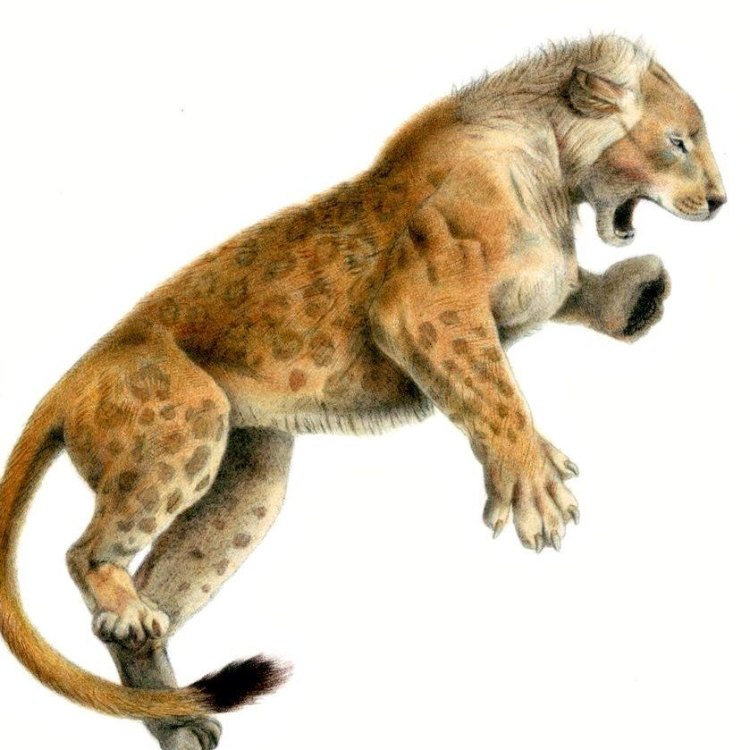
Cave Lion
- Adult Size: Similar to modern lions
- Average Lifespan: Estimated to be around 20 years
- Reproduction: Sexual reproduction
- Reproductive Behavior: Similar to modern lions
- Sound or Call: Unknown
- Migration Pattern: Unknown
- Social Groups: Unknown
- Behavior: Similar to modern lions
- Threats: Climate change, hunting by early humans
- Conservation Status: Extinct
- Impact on Ecosystem: Unknown
- Human Use: Unknown
- Distinctive Features: Long, shaggy mane and robust build
- Interesting Facts: Cave lions are known from numerous cave paintings in Europe
- Predator: None
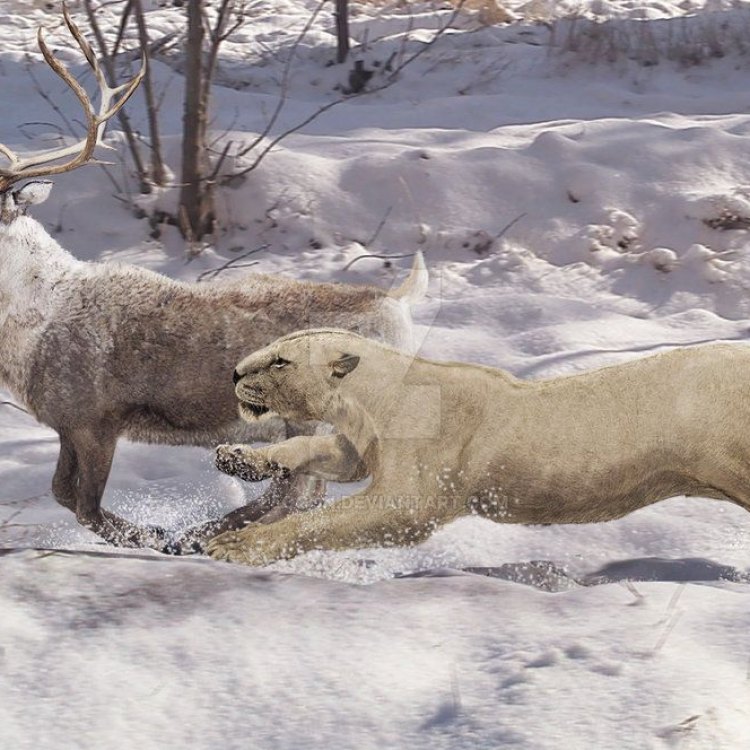
Panthera leo spelaea
The Cave Lion: A Fascinating Extinct Predator from the Ice Age
Tucked away in the annals of history, amidst the tales of extinct animals, there is a creature that roamed the Earth during the Ice Age and captured the imaginations of ancient humans with its striking appearance and elusive nature. The Cave Lion, scientifically known as Panthera leo spelaea, may not be as well-known as its living relative, the African Lion, but it is a formidable predator that deserves to be highlighted and remembered.The Cave Lion was first identified through a jawbone found in Germany in 1810. Since then, numerous remains have been discovered in caves throughout Europe, giving rise to its scientific name that translates to "cave lion of the caves PeaceOfAnimals.Com." This magnificent creature shared many physical and behavioral similarities with modern lions, yet it also had unique features that set it apart. Let's take a closer look at what made the Cave Lion a fascinating and fearsome predator.
Size and Lifespan
Adult Cave Lions were similar in size to modern lions, with males weighing up to 500-600 pounds and standing 4-4.5 feet at the shoulder. Females were slightly smaller, topping out at around 400-500 pounds. They had long, muscular bodies, with powerful legs and retractable claws that made them efficient hunters.
Their lifespan is estimated to be around 20 years, which is similar to modern lions. However, unlike today's lions, the Cave Lion did not have to contend with human interference and had the potential to live longer in its natural habitat.
Reproduction and Behavior
The Cave Lion, like modern lions, reproduced through sexual means, with females giving birth to litters of 1-6 cubs Common Grackle. The cubs were born blind and vulnerable, and it was the lionesses' job to hide them in dark, secluded areas until they were old enough to join the pride. This reproduction cycle is similar to that of modern lions, with lionesses forming strong bonds with their cubs and males being responsible for the protection of the pride.
The reproductive behavior of the Cave Lion is comparable to its living relative, as they were social animals that existed in prides. However, due to the limited data available on their behavior and social groups, it is unclear if they had specific migration patterns or how they interacted with other prides.
Distinctive Physical Features
The Cave Lion had several unique physical features that set it apart from its modern counterpart. Its most distinctive feature was its long, shaggy mane that extended from its head to its shoulders and down its neck. This mane served as insulation during the harsh winters of the Ice Age and gave the lion a larger, more imposing appearance.
Their robust build and short, broad skull also differed from modern lions, which experts believe was an adaptation to living in colder climates. Additionally, the Cave Lion had shorter legs and a more massive body compared to modern lions, indicating that it may have been a slower runner but still a ferocious predator.
Impact on the Ecosystem
The Cave Lion is believed to have played a crucial role in the ecosystem during the Ice Age. As apex predators, they helped maintain a balance in the food chain by regulating the populations of their prey, which included deer, bison, and other large herbivores. Their presence in the ecosystem also contributed to shaping the behavior and evolution of other species, creating a delicate balance that enabled the survival of diverse plants and animals.
Threats and Conservation
Despite their formidable appearance and position as apex predators, the Cave Lion was not immune to threats. The most significant danger they faced was the changing climate during the Pleistocene era, which ultimately led to their extinction. The decline of their prey and the resulting lack of food were also contributing factors to their disappearance. Moreover, the hunting and intensive use of their prey by early humans may have also had an impact on their survival.
The Cave Lion is classified as extinct and is no longer found in the wild. While there have been some attempts to restore the species through cloning and genetic engineering, these efforts have been unsuccessful. As such, the best we can do to preserve the memory of this magnificent animal is to continue studying its remains and preserving its legacy through art and literature.
Interesting Facts and Human Use
Cave Lions have captured the imaginations of humans throughout history, and there are many interesting facts and myths associated with them. They are known from several cave paintings in Europe, with the Chauvet Cave in France having some of the oldest and most well-preserved depictions. Ancient humans used these paintings as a way to honor and depict their lives alongside these predators, giving us a glimpse into their relationship with nature.
There is also evidence that ancient humans may have used parts of the Cave Lion for their own purposes. One example is a cave bear skull discovered in the Drachenhöhle (Dragon Cave) in Germany that had deep cuts, possibly from a carnivore's claw. Some experts believe that these wounds may have been inflicted by a Cave Lion, indicating that early humans may have used their remains for various purposes and possibly even revered them.
In Conclusion
The Cave Lion may be long extinct, but its legacy lives on through the stories and art of ancient humans and continues to captivate us today. Its existence is a testament to the diverse and fascinating creatures that once roamed our planet, and it serves as a reminder of how quickly things can change in the natural world. As we continue to learn more about this magnificent predator, it is our responsibility to remember and appreciate the role it played in shaping our ecosystem and preserving its memory for generations to come.
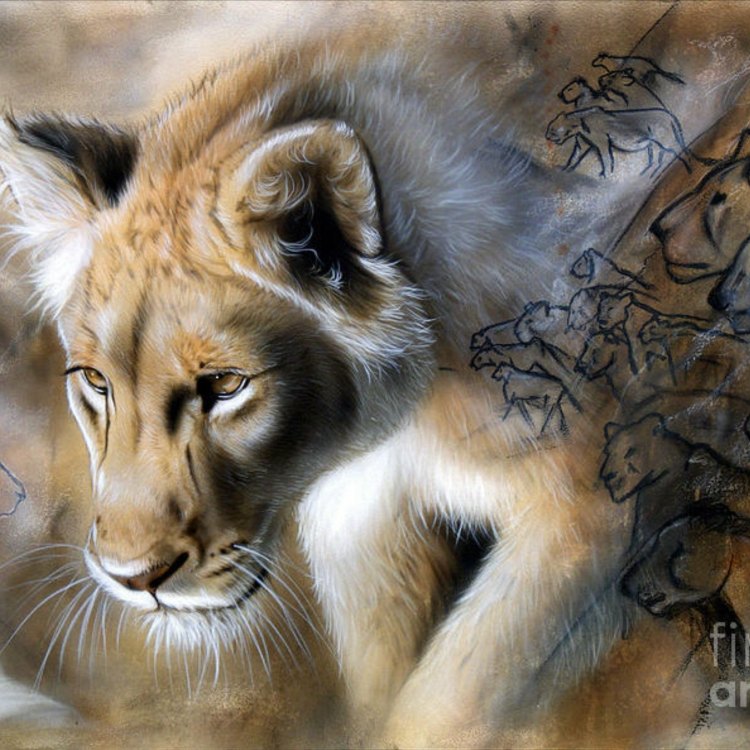
A Legendary Hunter: The Mighty Cave Lion
Disclaimer: The content provided is for informational purposes only. We cannot guarantee the accuracy of the information on this page 100%. All information provided here may change without prior notice.


